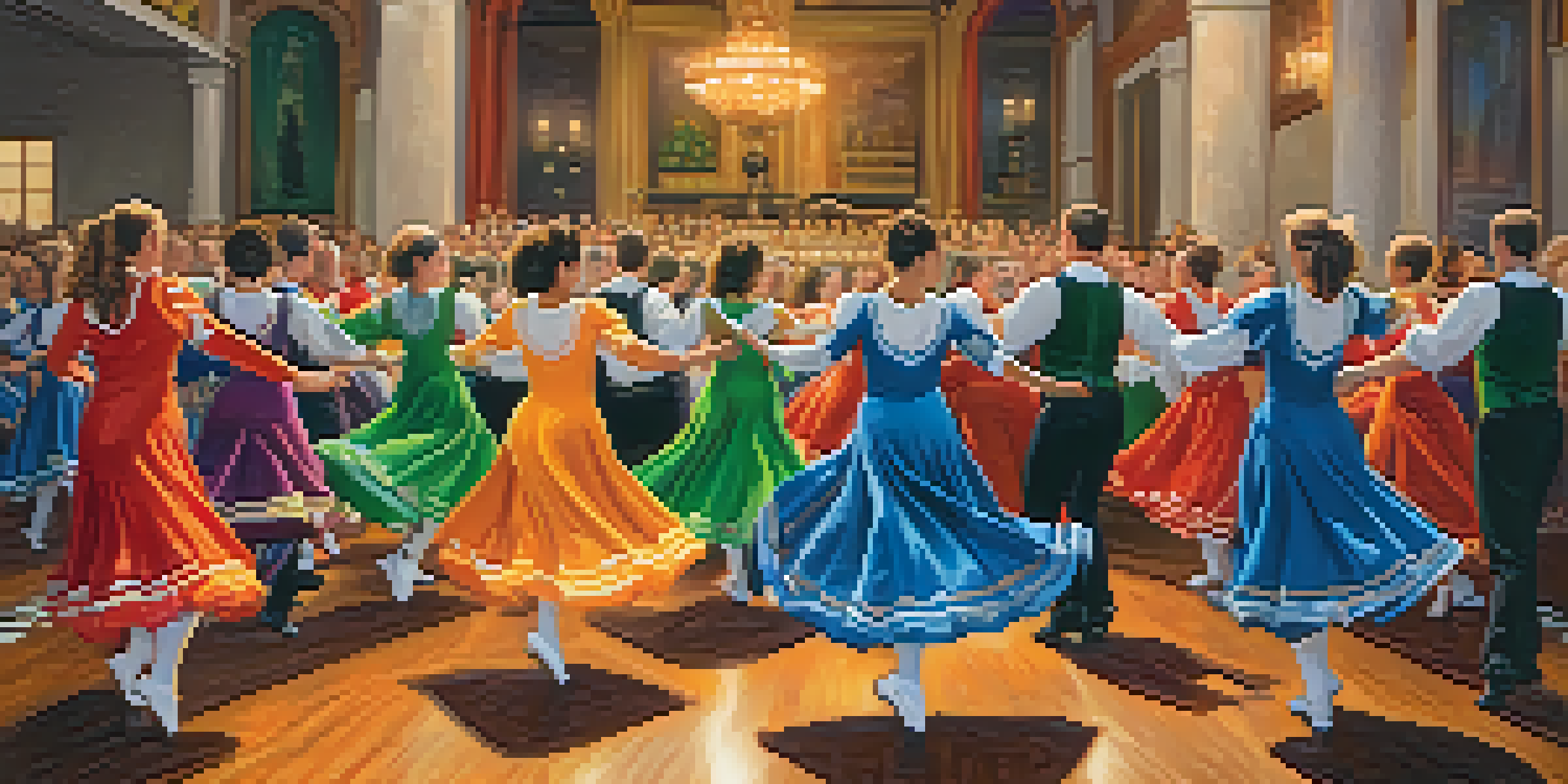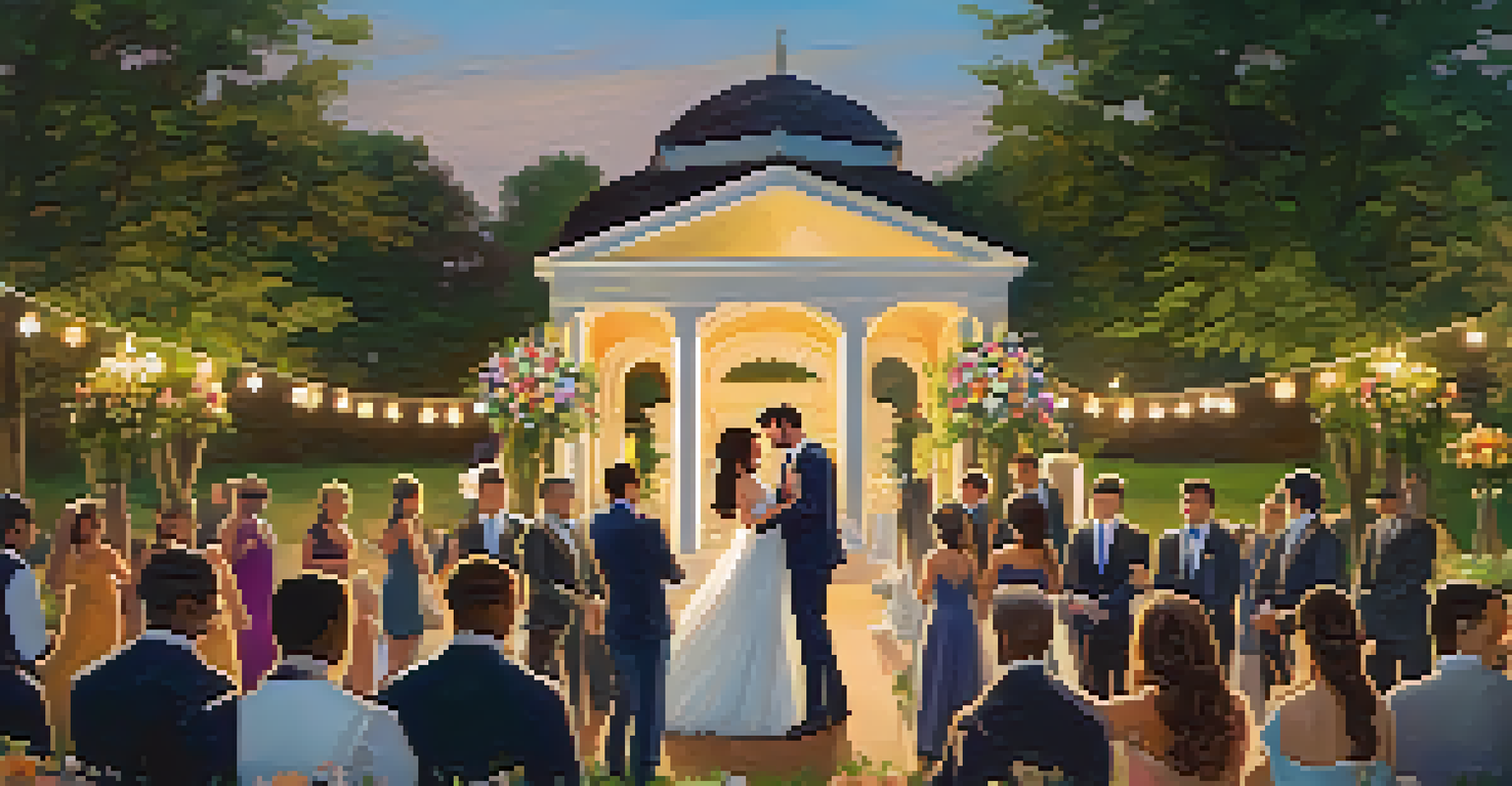The Interplay Between Dance and Language in Cultural Identity

Understanding Cultural Identity Through Dance and Language
Cultural identity is the tapestry of shared beliefs, practices, and values that define a community. Dance and language serve as vibrant threads in this tapestry, expressing emotions and narratives unique to each culture. They allow individuals to connect with their heritage and each other, fostering a sense of belonging and pride.
Dance is the hidden language of the soul.
For instance, traditional dances often tell stories that language alone cannot convey. Think of the Irish jig, which celebrates a rich history through rhythmic movement. Similarly, language carries the weight of culture, encapsulating idioms and expressions that may be lost in translation.
By examining how dance and language intertwine, we gain insights into the complexities of cultural identity. This interplay enriches our understanding of who we are as individuals within a larger societal framework.
The Role of Dance as a Language in Identity Expression
Dance can be seen as a universal language, speaking volumes without uttering a word. Through movement, individuals express feelings, experiences, and cultural narratives, creating a dialogue that transcends spoken language. For example, ballet tells stories of love, struggle, and triumph through its intricate choreography.

Moreover, various cultures have developed their own distinct dance forms that echo their values and traditions. The Haka, a traditional Māori dance, conveys strength and unity, while the Flamenco showcases the passionate spirit of Spanish culture. Each dance form serves as an embodiment of its cultural roots.
Dance and Language Shape Identity
Both dance and language serve as vital forms of expression that reflect and reinforce cultural identity.
In this way, dance not only reflects identity but also reinforces it. It becomes a powerful vehicle for storytelling, allowing communities to preserve and share their unique histories.
Language as a Tool for Cultural Transmission and Preservation
Language, much like dance, is a vital medium through which cultural heritage is passed down from generation to generation. Through storytelling, songs, and rituals, language keeps traditions alive and thriving. For example, Indigenous languages often encapsulate ecological knowledge and cultural practices that are critical for survival.
Language is the road map of a culture. It tells you where its people come from and where they are going.
The decline of a language often signals a loss of cultural identity, as unique expressions and worldviews may fade away. Efforts to revitalize endangered languages highlight the importance of maintaining this connection to heritage. Community initiatives, such as language courses and cultural events, play a crucial role in this preservation.
Thus, language acts as a bridge between the past and present, enabling individuals to navigate their cultural landscapes while fostering a sense of continuity.
The Interconnection of Dance and Language in Cultural Rituals
Cultural rituals often intertwine dance and language, creating a rich tapestry of expression. These rituals serve various purposes, from celebrating life events to marking significant transitions. For instance, weddings across cultures often feature dances that are accompanied by traditional songs, highlighting the joy and significance of the occasion.
In many African cultures, dance and song are integral to ceremonies, conveying messages of unity, healing, and transformation. The rhythmic movements and lyrics work together to create a powerful atmosphere of collective identity and shared experience. Participants often feel a heightened sense of belonging as they engage in these cultural expressions.
Cultural Rituals Unite Dance and Language
Cultural rituals often blend dance and language, enhancing communal bonds and shared experiences.
This interplay reinforces the notion that dance and language are not isolated forms of expression but interwoven elements that enrich cultural rituals and strengthen communal bonds.
The Impact of Globalization on Dance and Language
In our increasingly interconnected world, globalization has significantly influenced dance and language. While it allows for the sharing and fusion of cultural practices, it can also lead to the dilution of traditional forms. For example, hip-hop culture has spread worldwide, often blending with local dance styles but sometimes overshadowing indigenous forms.
Similarly, global communication has made languages more accessible but risks homogenizing linguistic diversity. The rise of English as a global lingua franca may diminish the use of local languages, leading to a loss of unique cultural expressions. This highlights the delicate balance between sharing and preserving cultural identity.
As we navigate this global landscape, it's essential to celebrate the richness of diverse dance forms and languages while advocating for their preservation. Embracing cultural diversity can lead to a more inclusive and vibrant global community.
Embodying Identity: Personal Stories of Dance and Language
Personal stories often illustrate the profound connection between dance, language, and cultural identity. For many individuals, dance serves as a means of reconnecting with their roots. Take the story of a young Latina who finds empowerment through traditional salsa dancing, rediscovering her family's heritage with every step she takes.
Similarly, language can shape our identities in powerful ways. A second-generation immigrant may learn their parents' native language to better understand their familial history, bridging the gap between generations. These personal journeys highlight how dance and language can intertwine to create a deeper sense of self.
Globalization Challenges Cultural Heritage
While globalization promotes cultural exchange, it also risks diluting traditional dance forms and languages.
Such narratives remind us that cultural identity is not static but a living, breathing aspect of who we are. By sharing these stories, we celebrate the diverse experiences that shape our collective identity.
Looking Ahead: The Future of Dance and Language in Identity
As we look to the future, the interplay between dance and language will continue to evolve, influenced by societal changes and technological advancements. Digital platforms allow for the sharing of cultural expressions across the globe, fostering a greater appreciation for diversity. This interconnectedness can lead to exciting new forms of artistic collaboration that blend various cultural influences.
However, it's crucial to remain vigilant about preserving the essence of traditional practices amid this evolution. Educators, artists, and community leaders play a vital role in promoting cultural heritage while encouraging innovation. By instilling a sense of pride in one's roots, we can ensure that future generations appreciate the value of both dance and language.

Ultimately, the future of cultural identity lies in our ability to celebrate and honor the past while embracing the possibilities of the present and future. This balanced approach will enable us to cherish the rich tapestry of human expression.